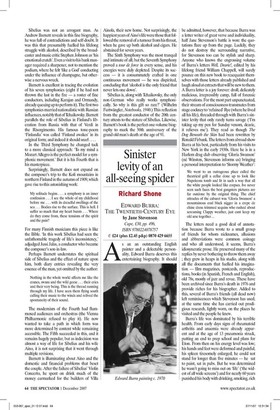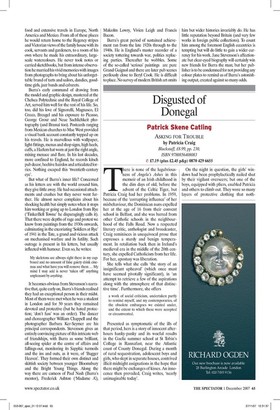Sinister levity of an all-seeing spider
Richard Shone EDWARD BURRA: THE TWENTIETH-CENTURY EYE by Jane Stevenson Cape, £30, pp. 496, ISBN 9780224078757 © £24 (plus £2.45 p&p) 0870 429 6655 As an an outstanding English painter and a delectable personality, Edward Burra deserves this entertaining biography. It should be admitted, however, that because Burra was a letter writer of great verve and individuality, half Jane Stevenson's battle is won: the quotations flare up from the page. Luckily, they do not destroy the surrounding narrative, for Stevenson too can be stylish and sharp. Anyone who knows the engrossing volume of Burra's letters Well, Deane!, edited by his lifelong friend William Chappell, will surely pounce on this new book to reacquaint themselves with those letters already published and laugh aloud at extracts that will be new to them. A Burra letter is a joy forever: droll, delicately malicious, irrepressibly camp, full of forensic observations. For the most part unpunctuated, their stream of consciousness transmutes from stage cockney to `retained' Rye (where he lived all his life), threaded through with Burra's sinister levity that only rarely turns savage (I'm taking up my pen for Sunday venom, dearie, it relieves me'). They read as though The Dog Beneath the Skin had been rewritten by Ronald Firbank. The letters from abroad show Burra at his best, particularly from his visits to New York in the early 1930s. Here he is in a Harlem drag club observing 'Gloria Swanson' (ne Winston, Stevenson informs us) bringing a personal interpretation to 'Stormy Weather': We went to an outrageous place called the theatrical grill a cellar done up to look like Napoleons tomb and lit in such a way that all the white people looked like corpses. lye never seen such faces the best gangsters pictures are far outdone by the original thing. The chief attracles of the cabaret was 'Gloria Swanson' a mountainous coal black nigger in a crepe de chine dress trimmed sequins who rushed about screaming Clappy weather, just cant keep my old arse together...
The letters need a good deal of annotation because Burra wrote to a small group of friends for whom nicknames, allusions and abbreviations were common coinage and who all understood, it seems, Burra's idiosyncratic prose. He preserved many of the replies by never bothering to throw them away ; they grew in heaps in his studio, along with all the documents that fuelled his imagination — film magazines, postcards, reproductions, books (in Spanish, French and English), old 78s, mostly of jazz and revue. These have been archived since Burra's death in 1976 and provide riches for his biographer. Added to this, several of Burra's friends (all dead now) left reminiscences which Stevenson has used; at the same time she has carried out prodigious research, lightly worn, on the places he visited and the people he knew.
Burra's life was dominated by his terrible health. From early days signs of rheumatoid arthritis and anaemia were already apparent and at the age of 13 pneumonia struck, putting an end to prep school and plans for Eton. From then on his energy level was low; his hands and feet were deformed and painful; his spleen tiresomely enlarged; he could not stand for longer than five minutes — he sat to paint, sat in pubs. But he was determined he wasn't going to miss out on 'life' (the widest of all wide screens') and for nearly 60 years punished his body with drinking, smoking, rich food and extensive travels in Europe, North America and Mexico. From all of these places he would return home to the Regency stripes and Victorian views of the family house with its cook, servants and gardeners, to a room of his own where he made his extraordinary, largescale watercolours. He never took notes or carried sketchbooks, but from intense observation he married his vivid memories with images from photographs to bring about his unforgettable brand of tarts and sailors, dandies, goodtime girls, jazz bands and cabarets.
Burra's early command of drawing from the model and graphic design, mastered at the Chelsea Polytechnic and the Royal College of Art, served him well for the rest of his life. So, too, did his love of Signore111 Magnasco, El Greco, Breugel and his exposure to Picasso, George Grosz and Neue Sachlichkeit pho tography (and Brassai too). Postcards ranging from Mexican churches to Mae West provided a visual bank account constantly topped up on his travels. He is marvellous with wallpaper, light-fittings, menus and shop signs, high heels, cuffs, a Harlem hat worn at just the right angle, mixing menace and flare. In his last decades, more confined to England, he records kitsch pub decor, beehive hairdos and articulated lor ries. Nothing escaped this `twentieth-century eye'.
But what of Burra's inner life? Concerned as his letters are with the world around him, they give little away. He had occasional attachments and crushes but they never went further. He almost never complains about his shocking health but simply notes when it stops him working or going up to London from Rye (TinkerBell Towne' he disparagingly calls it). That there were depths of rage and protest we know from paintings from the 1930s onwards, culminating in the excoriating 'Soldiers at Rye' of 1941 in the Tate, a grand and vicious attack on mechanised warfare and its futility. Such outrage is present in his letters, but usually inflected with humour. Even so, he writes: My skeletons are allways right there in my cupboard and no amount of false gaiety drink cinemas and what have you will remove them ... My mind I may add is never 'taken off' anything unpleasant by anything.
It becomes obvious from Stevenson's narrative that, quite early on, Burra's friends realised they had an exceptional person in their midst. Most of them were met when he was a student in London and for 50 years they remained devoted and protective (but he hated protection; 'don't fuss' was an order). The dancer and choreographer William Chappell and the photographer Barbara Ker-Seymer are his principal correspondents. Stevenson gives an entirely convincing picture of this intricate web of friendships, with Burra as some brilliant, all-seeing spider at the centre of affairs and fallings-out, monitoring its Sapphic turmoils and the ins and outs, as it were, of 'Bugger Heaven'. They formed their own distinct and skittish society between younger Bloomsbury and the Bright Young Things. Along the way there are cameos of Paul Nash (Burra's mentor), Frederick Ashton (Madame A), Malcolm Lowry, Vivien Leigh and Francis Bacon.
Burra's great period of sustained achievement ran from the late 1920s through to the 1940s. He is England's master recorder of a society tottering towards war, politics replacing parties. Thereafter he wobbles. Some of the so-called 'serious' paintings are pure Grand Guignol and there are later pub scenes perilously close to Beryl Cook. He is difficult to place. No survey of modern British art omits him but wider histories invariably do. He has little reputation beyond Britain (and very few works in foreign public collections). To count him among the foremost English eccentrics is tempting but will do little to gain a wider currency for his work. Jane Stevenson's affectionate but clear-eyed biography will certainly win new friends for Bun-a the man; but her publisher is to be condemned for not providing any colour plates to remind us of Burra's astonishing output, created against so many odds.






































































 Previous page
Previous page